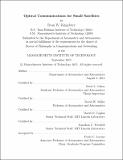Optical communications for small satellites
Author(s)
Kingsbury, Ryan W
DownloadFull printable version (2.399Mb)
Other Contributors
Massachusetts Institute of Technology. Department of Aeronautics and Astronautics.
Advisor
Kerri L. Cahoy.
Terms of use
Metadata
Show full item recordAbstract
Small satellites, particularly CubeSats, have become popular platforms for a wide variety of scientific, commercial and military remote sensing applications. Inexpensive commercial o the shelf (COTS) hardware and relatively low launch costs make these platforms candidates for deployment in large constellations that can offer unprecedented temporal and geospatial sampling of the entire planet. However, productivity for both individual and constellations of CubeSats in low earth orbit (LEO) is limited by the capabilities of the communications subsystem. Generally, these constraints stem from limited available electrical power, low-gain antennas and the general scarcity of available radio spectrum. In this thesis, we assess the ability of free space optical communication (lasercom) to address these limitations, identify key technology developments that enable its application in small satellites, and develop a functional prototype that demonstrates predicted performance. We first establish design goals for a lasercom payload archi- tecture that offers performance improvements (joules-per-bit) over radio-frequency (RF) solutions, yet is compatible with the severe size, weight and power (SWaP) constraints common to CubeSats. The key design goal is direct LEO-to-ground downlink capability with data rates exceeding 10 Mbps, an order of magnitude better than COTS radio solutions available today, within typical CubeSat SWaP constraints on the space terminal, and with similar COTS and low-complexity constraints on the ground terminal. After defining the goals for this architecture, we identify gaps in previous implementations that limit their performance: the lack of compact, power-efficient optical transmitters and the need for pointing capability on small satellites to be as much as a factor of ten better than what is commonly achieved today. One approach is to address these shortcomings using low-cost COTS components that are compatible with CubeSat budgets and development schedules. In design trade studies we identify potential solutions for the transmitter and pointing implementation gaps. Two distinct transmitter architectures, one based on a high-power laser diode and another using an optical amplifier, are considered. Analysis shows that both configurations meet system requirements, however, the optical amplifier offers better scalability to higher data rates. To address platform pointing limitations, we dene a staged control framework incorporating a COTS optical steering mechanism that is used to manage pointing errors from the coarse stage (host satellite body-pointing). A variety of ne steering solutions are considered, and microelectromechanical systems (MEMS) tip-tilt mirrors are selected due to their advantage in size, weight and power. We experimentally validate the designs resulting from the trade studies for these key subsystems. We construct a prototype transmitter using a modified COTS fiber amplifier and a directly-modulated seed laser capable of producing a 200mW average power, pulse position modulated optical output. This prototype is used to confirm power consumption predictions, modulation rate scalability (10 Mbps to 100 Mbps), and peak transmit power (e.g., 24.6W for PPM-128). The transmitter optical output, along with a simple loopback receiver, is used to validate the sensitivity of the avalanche photodiode receiver used for the ground receiver in the flight experiment configuration. The MEMS fine steering mechanisms, which are not rated for space use, are characterized using a purpose-built test apparatus. Characterization experiments of the MEMS devices focused on ensuring repeatable behavior (+/-0:11 mrad, 3-[sigma]) over the expected operating temperature range on the spacecraft (0°C to 40°C). Finally, we provide an assessment of the work that remains to move from the prototype to flight model and into on-orbit operations. Space terminal packaging and integration needs, as well as host spacecraft interface requirements are detailed. We also describe the remaining ground station integration tasks and operational procedures. Having developed a pragmatic COTS-based lasercom architecture for CubeSats, and having addressed the need for a compact laser transmitter and optical ne steering mechanisms with both analysis and experimental validation, this thesis has set the stage for the practical use of lasercom techniques in resource-constrained CubeSats which can yield order-of-magnitude enhancements in communications link eciency relative to existing RF technologies currently in use.
Description
Thesis: Ph. D., Massachusetts Institute of Technology, Department of Aeronautics and Astronautics, 2015. This electronic version was submitted by the student author. The certified thesis is available in the Institute Archives and Special Collections. Cataloged from student-submitted PDF version of thesis. Includes bibliographical references (pages 115-124).
Date issued
2015Department
Massachusetts Institute of Technology. Department of Aeronautics and AstronauticsPublisher
Massachusetts Institute of Technology
Keywords
Aeronautics and Astronautics.